The E46 M3 has remained an icon of BMW’s M division since they reached owners in late 2000. With a screaming straight-six upfront, a six-speed manual in the middle, and drive sent to the wheels at the rear, it was an absolute force to be reckoned with as it beat supercars with double the sticker price in testing. It was also a revolutionary product for the US-spec market. The prior M3 was watered down and cheapened for the states to fear that Americans wouldn’t buy such an expensive product. After all our complaints, BMW came to their sense and offered the E46 in true M-spec. Nearly 44,000 M3s had reached the US market by the end of production, cementing it as one of the most popular models to come from M, and its popularity hasn’t really gone away. Go to any track event or European car show, and you’re sure to see at least one present.
Sixteen years after the last one rolled off the production line, the automotive space isn’t what it used to be. The internal combustion engine is in its final days as a power plant, and a new generation of BMW enthusiasts are getting their licenses daily. Many people now view the E46 M3 as one of the last analog M cars ever made, and collectors and wannabe owners are chomping at the bit to get their hands on them. If you’re one of those people, we can’t blame you for wanting one, but you need to know a few critical things before you stop using your turn signals.
BMW E46 M3 Model Overview
BMW has a penchant for offering special or limited editions of their fastest cars. The E46 M3 was no exception; however, we weren’t privy to any in the States. We got the standard M3 as a coupe or convertible based on the E46 chassis. A year away from the end of production, BMW introduced the Competition Package for the M3 coupe that added a few features from the European special editions, but that was about it. Each car had the same engine, transmission options, and suspension setup. Definitely not the wide range of possibilities BMW likes to offer these days, but the E46 M3 didn’t need much to sell well.
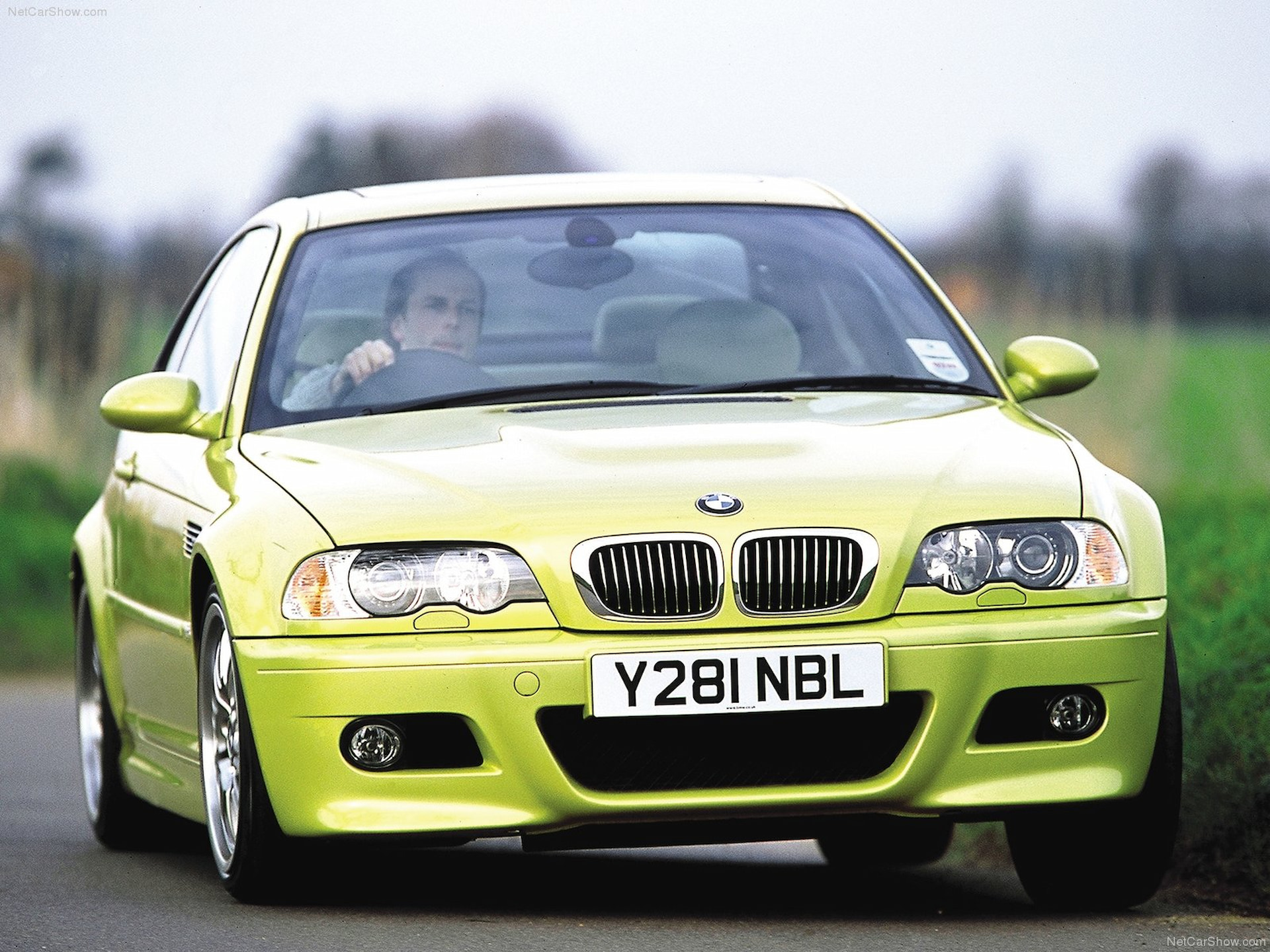
The crown jewel of the E46 M3 was, by far, its engine. Previous M3s were developed to go racing, and their free-revving, high-output engines were explicitly engineered to provide a basis for those racing cars. The S54B32 used in the E46 M3 was no different and remains a popular and revered engine in motorsport circles. With over 100 horsepower per liter and an 8000rpm redline, the S54 was one of the most technologically advanced engines of its time, backed up by numerous awards. It displaced 3.2L and used only the vacuum its six pistons created to pull in air. Where many performance cars of the decade were turning to forced induction, BMW stuck to its naturally aspirated roots. The engine remained the same throughout production without any power increase or significant modification. Even by the end, it was still making more power than the cheapest 911.
Backing up the S54 was one of two transmission options built around the same core gearbox. The traditional choice was a Getrag-built six-speed manual transmission; however, the paddle-shift gearbox was coming into its own around this time, and BMW was eager to dip its toe in the clutch-pedal-less pool. Their offering was the SMG, short for Sequential Manual Gearbox. It was built around the same six-speed Getrag manual gearbox but used a hydraulic system to operate the clutch and change gears. The driver would then select the gear changes with the paddles on the steering wheel or by pulling/pushing on the shift lever. Many praised the SMG at the time, but they’ve since fallen out of favor due to their temperamental behavior.
Regardless of the drivetrain choice, buyers could only have them in coupe or convertible body styles. The sedan body style introduced for the E36 M3 didn't return for the E46, leaving only the two-door models.
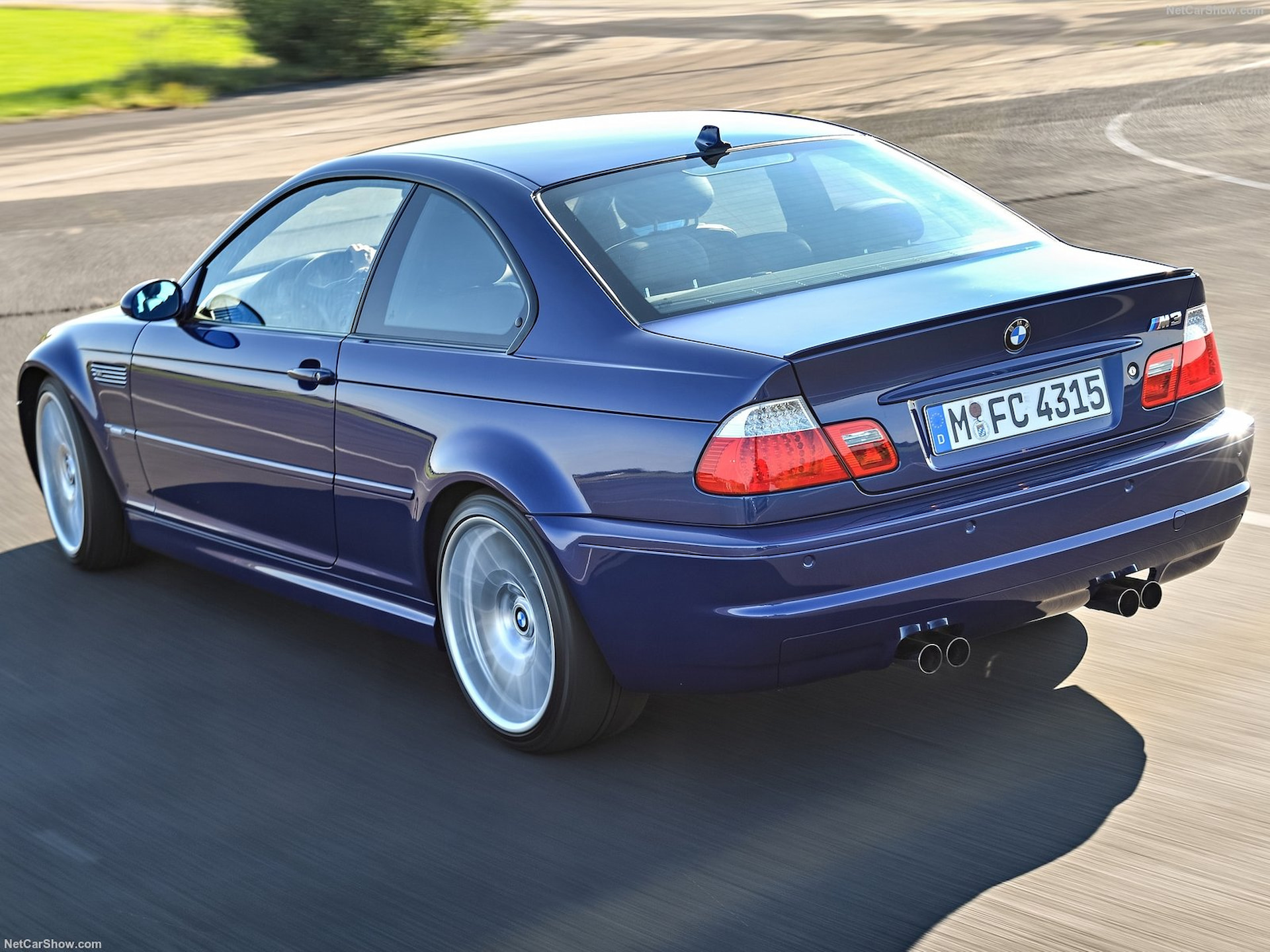
The boxy and angular lines of the ’90s BMW models melted into a flowing yet aggressively stanced chassis. Fat fender flares accentuated the significantly wider chassis, and the sculpted hood featured a “power bulge” to give no mistake of what lurked beneath. Of course, all of the signature BMW details were present, though the four headlights now had a much more distinctive shape that can only be associated with the E46 platform. Altogether, the E46 was an era-defining shape and one that has aged as well as any other.
Though, perhaps the most modernizing updates came inside the cabin. The E36 was a product of the nineties, and boy, did it look the part. Not necessarily in an offensive way, but it was undoubtedly outdated by the turn of the millennium. The new M3 ushered in the cell phone era with a distinctive aluminum beltline across the dash, knobless climate controls, and an LCD infotainment screen. In front of the driver was an all-new instrument cluster, too. Featuring titanium-ringed grey gauges, it delivered more precise information and informed the driver of a safe rev range based on the oil temperature. There were also radio controls on the steering wheel and controls for cell phone calls; it was an M3 for the modern age.
In 2005, BMW introduced the Competition Package, also known as the ZCP, instituting a few small but key changes to the aging model taken from the Europe-only special editions. One would first notice the 19’ wheels taken directly from the CSL, with its larger, two-piece, cross-drilled rotors behind them. Inside the cabin were some unique trim and a smattering of Alcantara-covered surfaces, including the steering wheel connected to a quicker steering rack. Two other exclusives for the Comp pack were the Interlagos Blue Paint and the M Track Mode setting of the Dynamic Stability Control.
The Competition pack was available only on the coupe models, so convertible buyers were left with the same components as the earlier cars. The M3 would continue until the end of the 2006 model year before becoming discontinued. What followed was a similarly good-looking and high-performance BMW sport sedan with a strong following like the E46—but that’s for another time.
BMW E46 M3 Spec Sheet |
|
| Engine Type: | Inline 6 |
| Displacement: | 3.2L (3246cc) |
| Horsepower: | 333 hp @ 7900 RPM |
| Torque: | 262 lb/ft @ 4900 RPM |
| Compression Ratio: | 11.5:1 |
| Max RPM: | 8000 |
| Induction: | Normally Aspirated, Individual Throttle Bodies |
| Manual Transmission: | 6-speed, Getrag 420G, H-pattern |
| "SMG" Transmission: | 6-speed, Getrag 420G, Electro-hydraulic Clutch/Shift Assembly |
| Ratios: | 4.23/2.53/1.67/1.23/1.00/0.83 |
| Final Drive: | 3.64:1 |
| Coupe Weight: | 3415lbs / 1550kg |
| Convertible Weight: | 3781lbs / 1686kg |
BMW E46 M3 Special and Limited Models
Though the US market never received any special edition E46s, BMW produced a handful for their various European markets.
M3 CSL
The standard E46 M3 is already lauded for its balance, handling, and motorsport-derived drivetrain, but it isn’t the gold standard among the chassis. That distinction falls to the M3 CSL, only the second BMW to wear the CSL badge and the first one to do so in nearly thirty years. CSL stands for Coupe Sport Lightweight, and the original 3.0CSL was just that. Its more powerful engine and strict diet made the E9 fit for homologation, while the wild aero and graphics ensured it would be remembered for generations to come. The E46 M3 CSL had some large shoes to fill, but M ensured it didn’t disappoint.
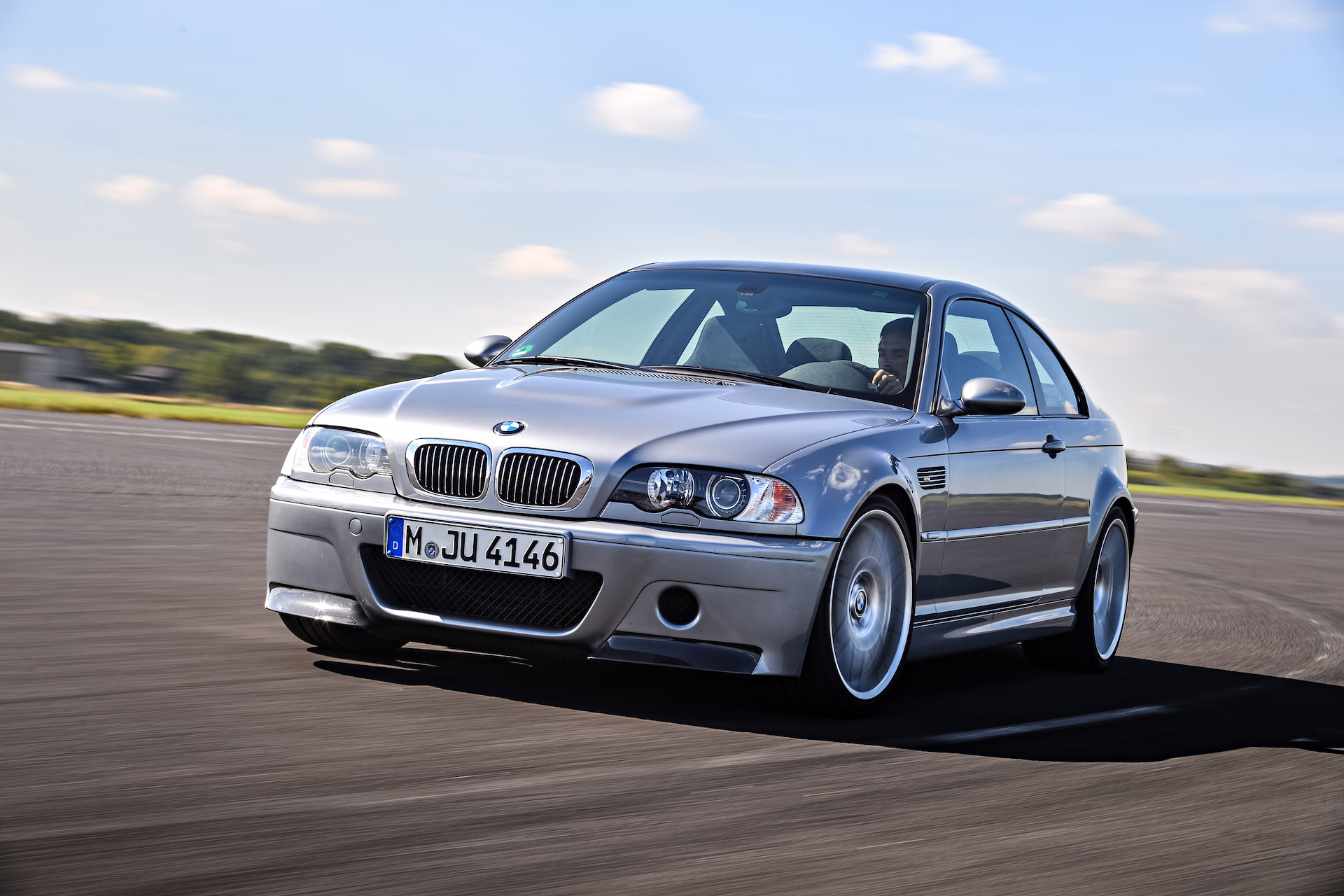
The CSL was a big change from the M3 as nearly every facet of the car was massaged or modified in some way. Previously steel components, the roof and trunk lid, were replaced by carbon fiber and plastic pieces respectively. Between those two was a rear window made from special thin glass. The plastic trunk lid was also a new shape, featuring a molded-in ducktail-like spoiler. The lift-reducing rear bodywork was rounded out by a small carbon fiber diffuser molded into the CSL-specific bumper. At the front, the aluminum hood remained unchanged, but a new front bumper was added. The new piece ditched the fog light and brake ducting holes for a single round hole on the driver’s side of the bumper face. Made from carbon-fiber-reinforced plastic, the bumper also had larger splitter-like pieces on its corners.
All of those new exterior bits could be painted in either Silver Grey Metallic or Black Sapphire Metallic over a black interior. The standard leather M3 interior bits made way for carbon door panel inserts, non-adjustable fiberglass bucket seats covered in “Reflex” cloth and Amaretta synthetic suede, and a similarly covered steering wheel. As if that wasn’t enough, BMW cut out the air conditioning and radio; they could be had but were optional. In total, BMW shaved 243 lbs from their standard car, putting the curb weight at about 3050 lbs.
That would be plenty for the 343 European-spec hp to throw around, but it didn’t make that. Instead, BMW took the standard S54B32 and turned it up a bit. New, larger camshafts, revised cam timing, modified exhaust valves, a thinner and freer-flowing exhaust system, and an all-new intake that used a MAP sensor all worked to produce 360 horsepower from the 3.2-liter straight six. BMW designated the new engine the S54B32HP, and the CSL remains the only car ever fitted with it.
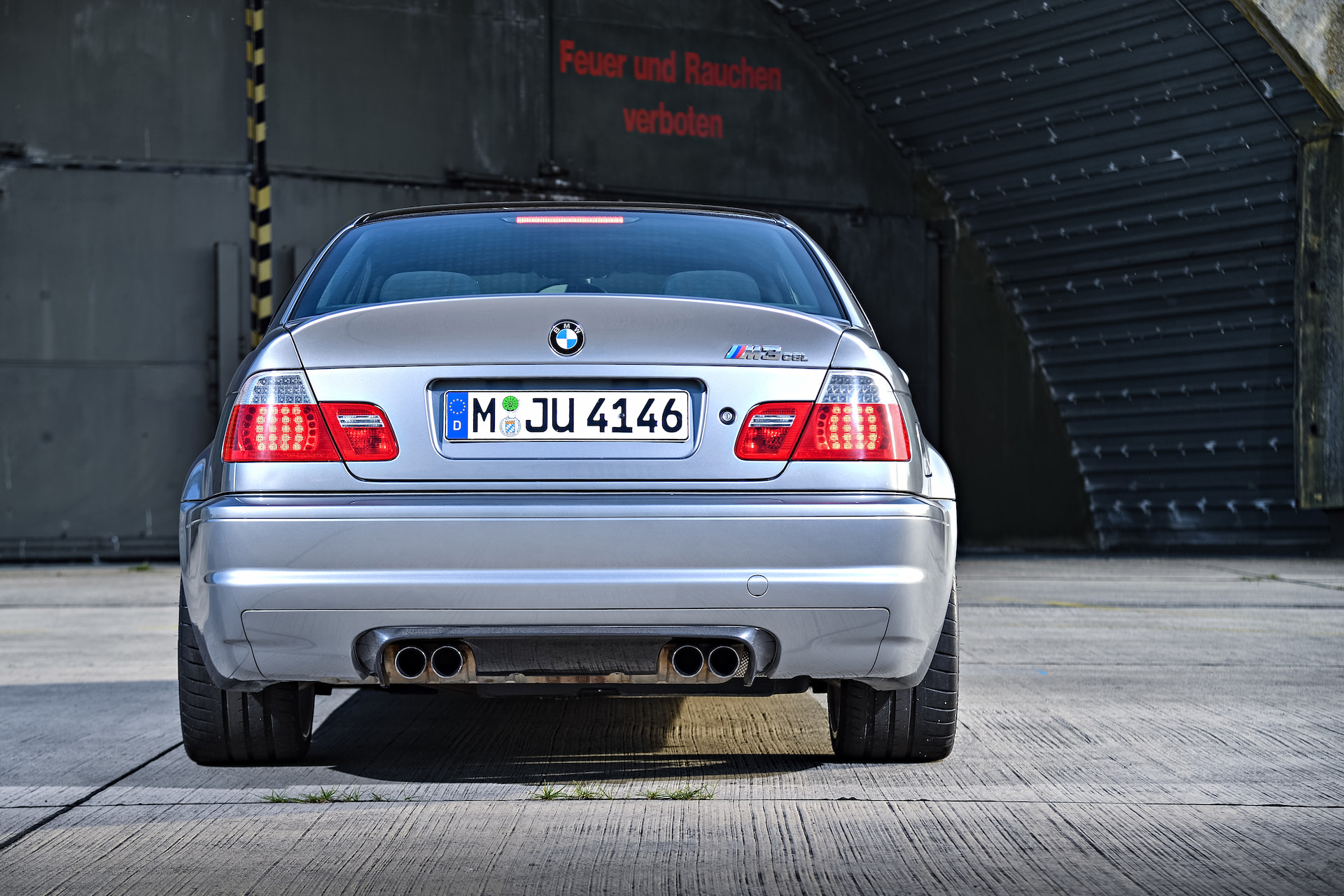
Along with the bespoke engine, and much to the chagrin of many prospective owners, every CSL was fitted with the SMG gearbox. It was technically faster than the standard manual, and the CSL was an exercise in outright performance, so it’s easy to understand why BMW did that—but it doesn’t mean we have to like it. Really though, that’s the only blight in the car.
Further modifications were made to the suspension and chassis to improve the already stellar handling characteristics. Helping shave rotating mass was the new two-piece, cross-drilled brake rotors. Their centers were made from aluminum and attached to the steel outer friction surface instead of being a solid piece of steel like the standard M3 discs. Aiding the brakes' stopping power were the lightweight 19” Style 163M “Cross-spoke” wheels made by BBS. BMW later offered similar versions on the 330i ZHP and with the M3’s Competiton package, although they have a different front width and offset. BMW wrapped the wheels in Michelin Pilot Sport Cup tires, which offered the driver incredible grip when matched with the revised springs, dampers, and larger sway bars.
Years on, the M3 CSL remains a benchmark for standard M3 owners and a god among the M cars. Not one list of the all-time best M cars is ever seemingly complete without the CSL, even if that’s not what BMW development chief Klaus Frolich wants to hear. Owning one of the 1383 made is an incredibly special opportunity, though one we Americans were never able to experience on our own shores.
M3 GTR
Like nearly every German manufacturer, BMW's history is incomplete without motorsports. Their racing heritage can be traced back to the 1930s, with specially built models and regular ones repurposed for motorsport. Their sporty sedans and coupes became regular faces in touring car and endurance events in the sixties thanks to the powerful engines and balanced chassis the Neue Klasse models provided. Special homologation models like the E9 3.0CSL followed, and the birth of M, BMW's motorsport division, came with it. However, their greatest road car turned racing car is somewhat of a legend in and of itself. It was born out of anger and dominated the competition in its only year of use before being retired from championship competition.

The American LeMans Series was a racing series that ran from 1999 to 2013. In its earliest days, the competition featured significant manufacturers like BMW, Porsche, and Ferrari, alongside smaller, hardly known makes like Panoz, Ascari, and Spyker, all going head to head in multi-class racing across America. BMW's E46 M3 was primed to be a main contender in the lower GT class, competing against Porsche, Ferrari, and Callaway, but some fishy rules regarding restrictor size put the 3.2-liter straight six at a disadvantage to the new, 996-based GT3R. Unhappy with the response from the governing body, BMW set out to create the M3 GTR.
ALMS GT class rules stipulated that a model seeking homologation must be sold on multiple continents and released within 12 months of competition. So BMW supposedly built ten examples, including a few prototypes, offered them to exclusive customers across the globe, and had a car that would go on to wipe the floor with the Porsches. It turns out that BMW only built three cars, and none ever left their care, but the FIA was none the wiser at the time.
Fully knowing that the S54 couldn't give BMW the power they were looking for, M pulled out the six and dropped in the P60B40, a 4.0-liter, flat-plane crankshaft V8. The compact, all-aluminum engine was created specifically for this application, featuring bespoke engine components and a dry-sump oil system. Of course, BMW didn't stop the drivetrain improvements there, as they then ditched the standard gearboxes for a six-speed sequential. The body was also explicitly redesigned for racing. Carbon-fiber-reinforce plastic was used for the hood, roof, and bumpers for maximum weight savings. At the rear, M added a rear spoiler to balance the downforce created by the new front bumper.
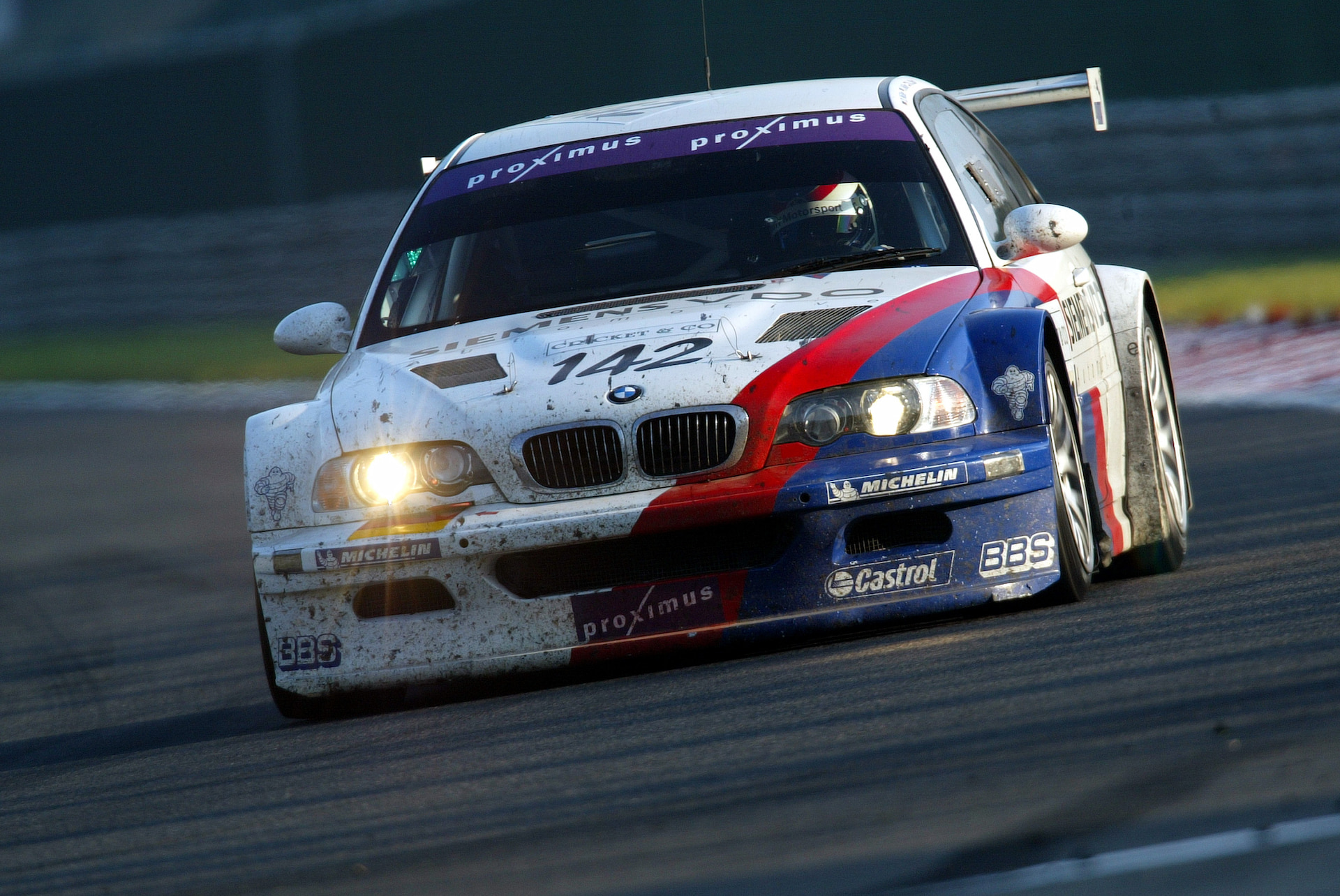
While none of the GTRs ended up in customers' hands, the race car crushed the competition in 2001. BMW Motorsport and Jörg Müller took home the manufacturer's and driver's championships in the GT class, managing seven consecutive victories. After that season, the rule-makers changed homologation requirements to 100 cars a year, so BMW opted to pull the GTR from the competition. However, it did live on in the Need For Speed: Most Wanted video game as the final boss' car, where it arguably gained more popularity than it did from its racing career. BMW wheeled the race car out just a few more times, taking back-to-back wins at the 2004 and 2005 Nurburgring 24 Hours.
M3 “30 Years of BMW M”
In 1972, a team of around thirty BMW employees set out to take the E9 3.0CS and homologate it for racing. They developed the 3.0CSL, a stripped-out, souped-up coupe that would dominate the European Touring Car Championship competition and the Deutsche Rennsport Meisterschaft. In the process, they became the first employees of BMW Motorsport. Renamed BMW M, 2002 marked the division’s thirtieth anniversary, and a commemorative M3 was available in Germany just for the occasion.
BMW produced 30 of the limited editions, ten in each of the three paint and two-tone interior combinations they offered. Those combos were Imola Red II paint with Imola Red/Black extended Nappa leather, Estoril Blue metallic paint with Estoril Blue/Black extended Nappa leather, and Velvet Blue metallic paint Ink Blue/Black extended Nappa leather. The limited editions were also treated with Anthracite Birchwood trim, Bi-Xenon headlights, PDC, heated front seats, and the Harmon/Kardon sound system.
Beyond the extensive options list, the 30YoM editions were standard M3s under the skin without any other performance-enhancing modifications. As sales were limited to thirty models during the spring of 2002 in Germany only, it’s safe to say that these editions are some of the rarest BMW ever produced.
M3 Silverstone Edition
The Germans weren’t the only ones to get a limited edition model. In 2004, BMW produced 50 Silverstone editions exclusively for the UK market. Each example was painted in Silverstone Metallic over a Dark Estoril Blue extended Nappa leather interior. The exclusive paint is excellent for owners, but it’s a shame it wasn’t available on other examples. Silverstone Metallic is a stunning shade that transitions from silver in overcast light to a vibrant pale blue in sunlight.
Finishing out the interior was black mats with Estoril Blue piping and the Aluminum Cube trim. Like the 30YoM edition, the Silverstone cars were given several expensive options as standard, including the Harmon/Kardon sound system, Style 163M wheels, and navigation system. Other than that, they were still based on a standard M3. Neither the engine nor suspension saw any tweaks, but buyers did have a choice of the gearbox. Thirty manuals and 20 SMGs were produced.
BMW E46 M3 Drivetrain & Chassis Breakdown
Although many love how it looks, most people buy an E46 M3 for the way it drives. Its balance through the corners, never-ending pull to redline, and ship anchor brakes made it a favorite among motorsports enthusiasts and the general public alike. Maintaining an E46 M3 yourself is a pretty straightforward process and one you can do yourself with some tools. But before you get started, you should know what you’re working on.
Engine
The S54 engine fitted to every US-spec M3 was a high-strung, high-performance engine that needed strict care and service to perform at its highest levels regularly. Based on an engine developed for motorsports, the engine block was cast from iron and capped with a cast aluminum cylinder head that featured dual overhead camshafts. The rotating assembly used a forged and nitrided crankshaft fitted with graphite-coated, forged connecting rods and cast pistons. The S54 was even fitted with a motorsports-like oil pump system that pulled oil from the main part of the pan and scavenged it from the front during excessive g-forces.
The S54’s true magic comes from its cylinder head. New for the S54, it shaved weight and complexity for its predecessor, helping the engine survive at high rpm. Slightly larger valves, new camshafts, bigger intake ports, and a revised dual VANOS with infinite adjustment all helped the straight-six screamer produce 333 horsepower at 7900rpm. For the first time, the US model received the individual throttle bodies that the European markets received on the E36. Pulling from a large airbox, the ITBs gave the S54 lightning-quick response and an intake noise that puts today’s modern engines to shame.
It wasn’t all sunshine and rainbows, though. Because the S54 was so high-strung, owners needed to abide by a few strict rules. The oil temperature was critical to their high-rpm ability; too low of a temp and engine damage would occur. BMW knew owners couldn’t do that without help, so they gave the M3 a tach with warning lights that determined how high the engine could be revved depending on the oil temp. When it came time to change that oil, it needed to be the Castrol TVS specially formulated to BMW’s specifications. Unfortunately, even if those stipulations were abided by, the engine could still hurt itself. The original bearings used for the connecting rods were not as strong as they needed to be, and many owners were caught out after they disintegrated and killed the engine.
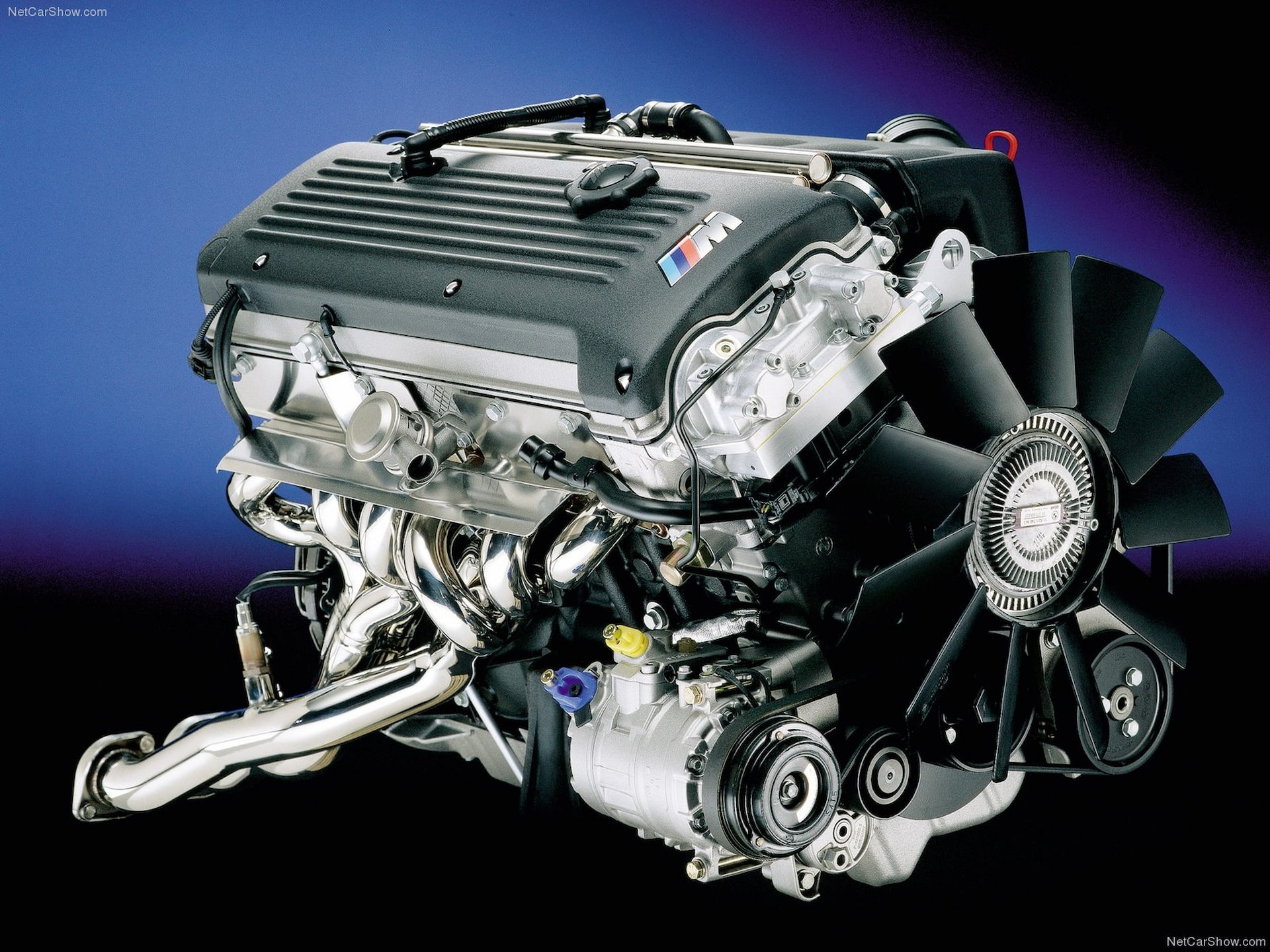
The issues didn’t stop there either. The advanced VANOS system was great when working, but that happened less than many owners expected. There are several significant pathways that the VANOS system could fail, and a few of those could take the rest of the engine with it. Improper bolt grading, poorly engineered tolerances, and the incorrect rubber compound for seals were some of the culprits of the most significant issues. However, you shouldn’t worry about that too much these days. Those problems have existed since the E46 M3 was in production, and although BMW never fixed them, the aftermarket did it themselves. Stronger components machined to the correct tolerances and fitted with proper seals can be purchased from several BMW performance specialists for near the price of Genuine BMW components. All it takes to sure up the S54 is a few bucks and some elbow grease.
Once the trouble spots have been addressed, the fun can start. The S54 has plenty of grunt to shove you and your passengers into the very comfortable and supportive seats in stock form. As long as you keep the oil and water in the proper operating temperature range, they handle plenty of spirited driving, track days, and autocross. If and when the 333 horsepower is no longer enough, there are a few ways to pull more power out.
FCP Euro's Definitive S54 Engine Guide
Bolt-on modifications like headers, exhaust systems, underdrive pulleys, and intakes do free up a decent chunk of power and essentially bring the S54 up to the power levels of the M3 CSL’s S54B32HP. Pop in a set of more aggressive camshafts, and you’ll be putting down more wheel horsepower and the factory’s crank horsepower rating. Stroker kits or forced induction are the next steps in power, performance, and pricing. Settling on one of those upgrades should be based on expert opinion and guidance to avoid a lackluster result and the feeling of wasted money.
Transmissions
Like every great performance car from that era, the M3 came with a slick-shifting, six-speed manual as the standard transmission option. The transmission of choice was the Getrag 420G, also used by the M5. It was a tried and trusted gearbox when the E46 M3 hit production and was one of the few carry-over parts from the E36.
The other transmission option was the SMG, a “flappy paddle” gearbox, as some would say. Unlike the dual-clutch transmissions we have now, the SMG was based around the same Getrag 420g as the manual. In fact, it was a nearly identical gearbox save for the extra hydraulic components. BMW and Getrag made the clutch and gear changes controlled by a series of hydraulic pumps and actuators that would respond at the tug of a paddle or flick of the gear lever. BMW even allowed drivers to adjust how aggressively they wanted the system to shift at the pull of a paddle.
Read a recent review of the SMG Gearbox 20 years later, here!
It was a good performer during aggressive driving, but clutch operation could be pretty rough in slower conditions, especially take-off. As far as computers had come by 2001, they weren’t quite smart enough to have a smooth and quick take-off—a good portion of the time; it was neither as the control unit struggled to manage clutch slip. These days people tend to avoid the SMG-equipped M3s when they can, but that also has a lot to do with their reliability. The good news is that there were more manual M3s made than SMGs, and the SMG can be converted to a true manual using Genuine BMW parts.
If you must have an SMG M3 for whatever reason, be sure to have some money stashed away for the eventual repairs. Nearly every single piece of the SMG can go wrong, including the SMG pump, solenoids, clutch actuator, clutch position sensor, and even the relays. Certain fixes like the relays are genuinely inexpensive, but anything more than that gets pricey fast, especially considering a BMW specialist is needed to make them. Those issues and their commonality have people staying away or converting them.
Chassis & Suspension
There are a few key reasons why the E46 is still discussed in such a respected way, and a large part of that is down to the chassis. The classic BMW sport sedan balance and handling characteristics were in full effect on the E46 M3, which to many, represents the last “real” M car ever made. Compounding the rose-tinted-glasses view of the handling are the non-suspension characteristics connected to it.
The hydraulic power steering system is heavily weighted and talkative, delivering feedback unmatched by today’s electronically assisted systems. Connected to the significantly widened front track compared to the E36, the 3400lb E46 has the feel enthusiasts and journalists are looking for. This size, too, isn’t remotely close to that of today's cars. The 2022 G20 M3 is roughly 188” long and 75” wide, whereas the E46 is 12” shorter in length but only 5” smaller in width. Of course, while those factors do help, the suspension and its engineering deliver the bulk of the performance.
Luckily for BMW, they already had an excellent design with the E36 M3 and simply modified it to suit the E46. The design at the front axle is a MacPherson strut that utilized a twin-tube damper and coil-over spring arrangement for damping control and a single “batwing” forged aluminum lower control arm to control motion. At the rear, a multi-link architecture utilizes a large trailing arm to support the wheel hub and two separate control arms to triangulate the design. A split damper and coil spring setup control damping. Nearly all joints are free of rubber, and instead, use either a Heim-joint-like monoball or a ball joint. As I’m sure you know, the E46 M3 is a regular at grassroots motorsports events for its motorsports-like engine and well-balanced chassis. However, there is quite a lot of work needed to make the M3 a safe race car, as BMW didn’t do all of its homework regarding chassis design.
FCP Euro's E46 M3 Suspension & Brake Guide
Whether from the increased stress put on the chassis by the 3.4” and 1.8” wider track front and rear, respectively, or from the lack of rubber in the suspension, or a combination of factors, the original steel used to build the bodyshells is not strong enough. We all saw the issues begin on the E36 chassis, and BMW didn’t fix them, so they carried right over to the new car.
In regular cases, the front strut towers, trailing arm bushing mounting points, rear subframe mounting points, trunk floor, and shock towers will likely deform and begin to crack under driving pressure. In the most extreme cases, the broken chassis’ have torn themselves apart beyond repair or caused significant accidents. However, like the SMG and S54 issues, the chassis cracking is very well known, and complete chassis reinforcement kits are available from several BMW specialist performance shops.
Unfortunately, you’ll also have to worry about the bushings in the rear, especially those used for the trailing arms and the subframe. No bushing is designed to last the car’s life, but the pieces used by BMW couldn’t last anywhere near the length they would last on their earlier cars. In some cases, the worn bushings can help accelerate the chassis wear and any cracks, so having healthy bushings and mounts is a must.
Brakes
The brakes are very straightforward, unlike the other parts of the drivetrain and chassis. Disc brakes are present at all corners and use an ABS to prevent lock-up. The front and rear calipers are single-piston sliders, though they are different calipers and clamp down over vented steel rotors. The rear calipers handle emergency/parking brake duties.
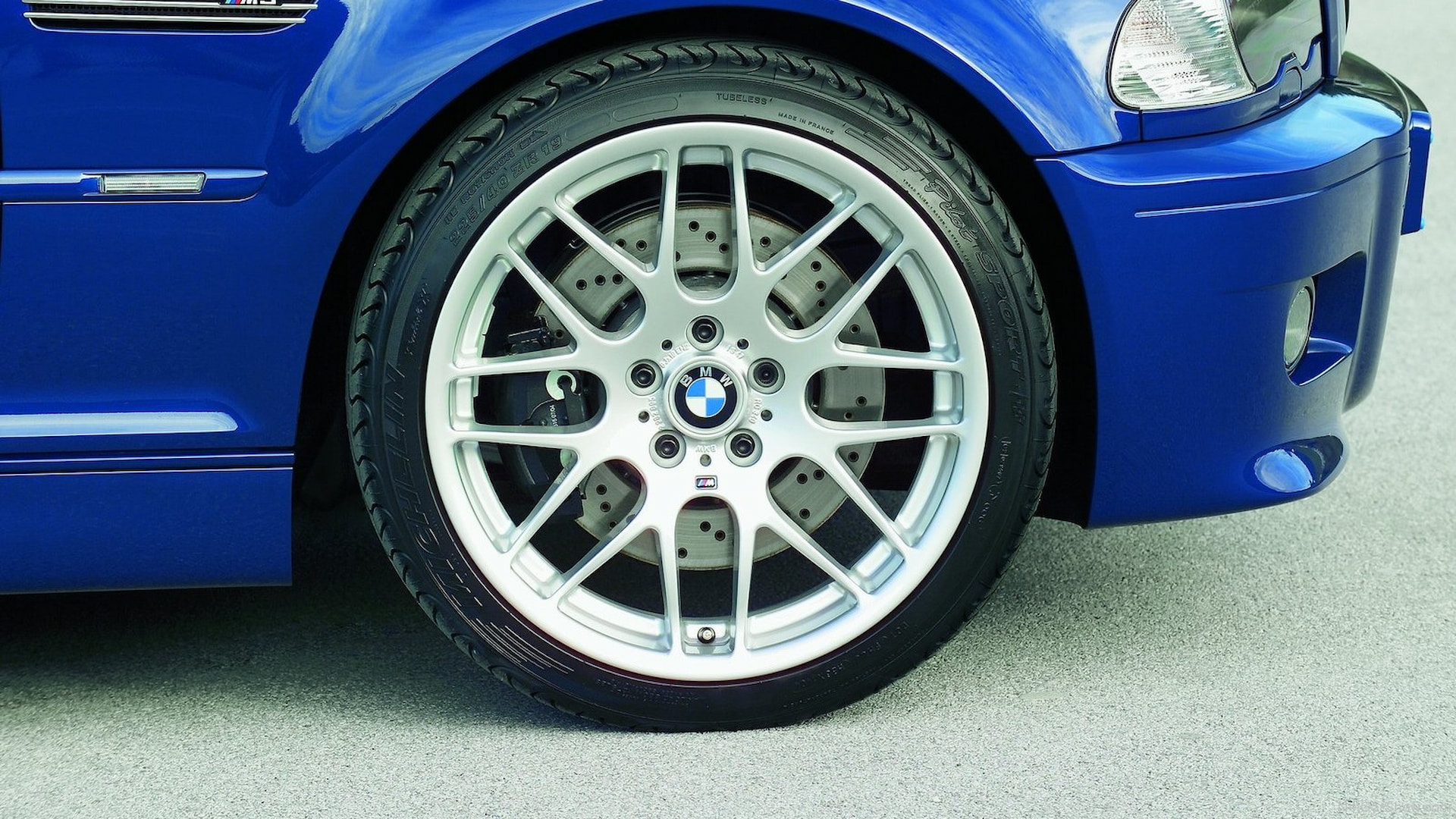
The options package connected to the chassis determines the type and size of the rotor. Every model between 2001-2004 uses a single-piece blank-face rotor measuring 335mm upfront and 328mm at the rear. The competition package changed the rotor construction and size of the rotors. The revised rotors were a two-piece design with drilled faces to help improve the rotor's durability and longevity under sustained heavy braking. The rotors were also lighter than those fitted to the earlier cars, even with the front pieces being 10mm larger. Rear rotors remained 328mm but were given the two-piece construction.
There isn’t much else that can be said for the brakes. The sliders are easy to work on and perform well in most street applications, so there isn’t an enormous need to go with something more aggressive. Track time is its own ballgame, and an upgrade to a big brake kit is a safe choice. Kits are available from nearly every aftermarket brake company you’ve heard of and from a few you haven’t, leaving plenty of options for most budgets. More minor upgrades like stainless-steel braided brake lines and aftermarket pads are a perfect budget option that will assuredly improve the feel and braking characteristics.
BMW E46 M3 Interior & Exterior Breakdown
Besides being one of the best driving Ms around, people can't get enough of the E46's looks either. It's been sixteen years since the last M3 left the dealer floor, and the model has remained as popular as ever. Is it its relatively small size and lighter weight over the newer cars, or is it the design language itself? The E46 is certainly less busy than the F80 and G20 M3/4s but lacks the interior refinement of the latest models. Whatever it is, support for the E46 isn't going anywhere.
Exterior
Alone and to the untrained eye, the M3 looks like any other E46 3-series. The difference is far more apparent for others, especially when parked next to each other. It’d be incorrect to say that they aren’t styled similarly, considering they are from the same family, but the M3 has all of the 3-series styling cues turned up to 11 to match the performance of the drivetrain and chassis.
Most prominent were the M3’s flares. The original M3, the E30, had shape-defining box flares that housed wider wheels and tires, allowing the homologated race cars to use even wider versions for competition. The protruding flares were ditched for the E36 but returned for the E46. The extra-wide fenders and quarters emphasized the significantly increased track width and housed the 18” or 19” Style 67 or 163M wheels. The rest of the profile was very similar, minus the 3.0CS-like vent in the fender just aft of the wheel arch. The bumper, fenders, and hood were unique to the M car, with the latter being made from aluminum because of weight savings. At the back, the taillights were identical to any other E46 coupe, but the trunk lid and bumper are exclusively M.
As they typically do, BMW offered many great paint codes for owners to choose from. Thirteen were provided in the US from the beginning of production to the end on non-special editions, though not all were available for the entire run. Fern Green Metallic and Black Sapphire Metallic were the two paints we didn’t get, not including special edition colors, and they happen to have been offered for the shortest amount of time—around one model year each. Phoenix Yellow Metallic and Laguna Seca Blue were introduced for the M3 and have become a favorite among enthusiasts and collectors as they’re two of the less traditional colors. Like Alpine White III and Imola Red II, others returned from previous generations.
Of course, several parts of the M3 received various small updates throughout production. The original Xenon headlights were replaced with Bi-xenon units for the ‘02 model year, and later the taillights moved from halogen bulbs to LED. Around the same time as the taillight switch, BMW also changed up some of the paint offerings, like a switch from offering Topaz blue for Mystic blue, and changed a small piece of trim on the coupe trunk.
Exterior options offerings were relatively limited for the top-spec 3-series, with only a handful or so offered. Exclusive to the convertible was a paint-matched hardtop, though the two body styles shared nearly every other option, including the rear park distance control, metallic paint, and Xenon headlights. The “cross-spoke” Style 163M wheels, like those used on the M3 CSL, were available only on the coupes.
Along with the Style 163M wheels, the M3 CSL had several other exterior differences that, while not offered in the States, are still available for order through US dealerships and aftermarket retailers. The front and rear bumper and the trunk lid were all different for the lightweight model and, to many, are the best looking of the OE BMW parts. The trunk lid is likely the most popular modification, but the factory plastic piece isn’t cheap. Its raised trailing edge forms a smooth ducktail-like spoiler for a bit more flair and likely some aerodynamic benefit; however, owners typically add them for their weight savings and appearance benefits. The CSL’s front bumper eliminated the foglight grilles for a single round opening to feed the intake on the driver’s side. The leading edge also received more prominent splitter-like pieces for improved aerodynamics. At the rear, there wasn’t much change other than the center of the bumper. Instead of the bumper cover coming down around the exhaust tips, the CSL bumper had a small carbon fiber diffuser surrounding the tips.
Interior
Opening up one of the M3’s two doors revealed a classically BMW driver-focused interior. The components used in the outgoing E36 were dated, but the basic layout needed no modification, so BMW went for evolution instead of revolution. Updated radio and climate control units modernized the touchpoints, featuring screens and the Drivelogic system. Extra radio controls and BlueTooth cell phone controls were even present on the steering wheel. All of BMW’s changes were to update the M3 for the new millennium.
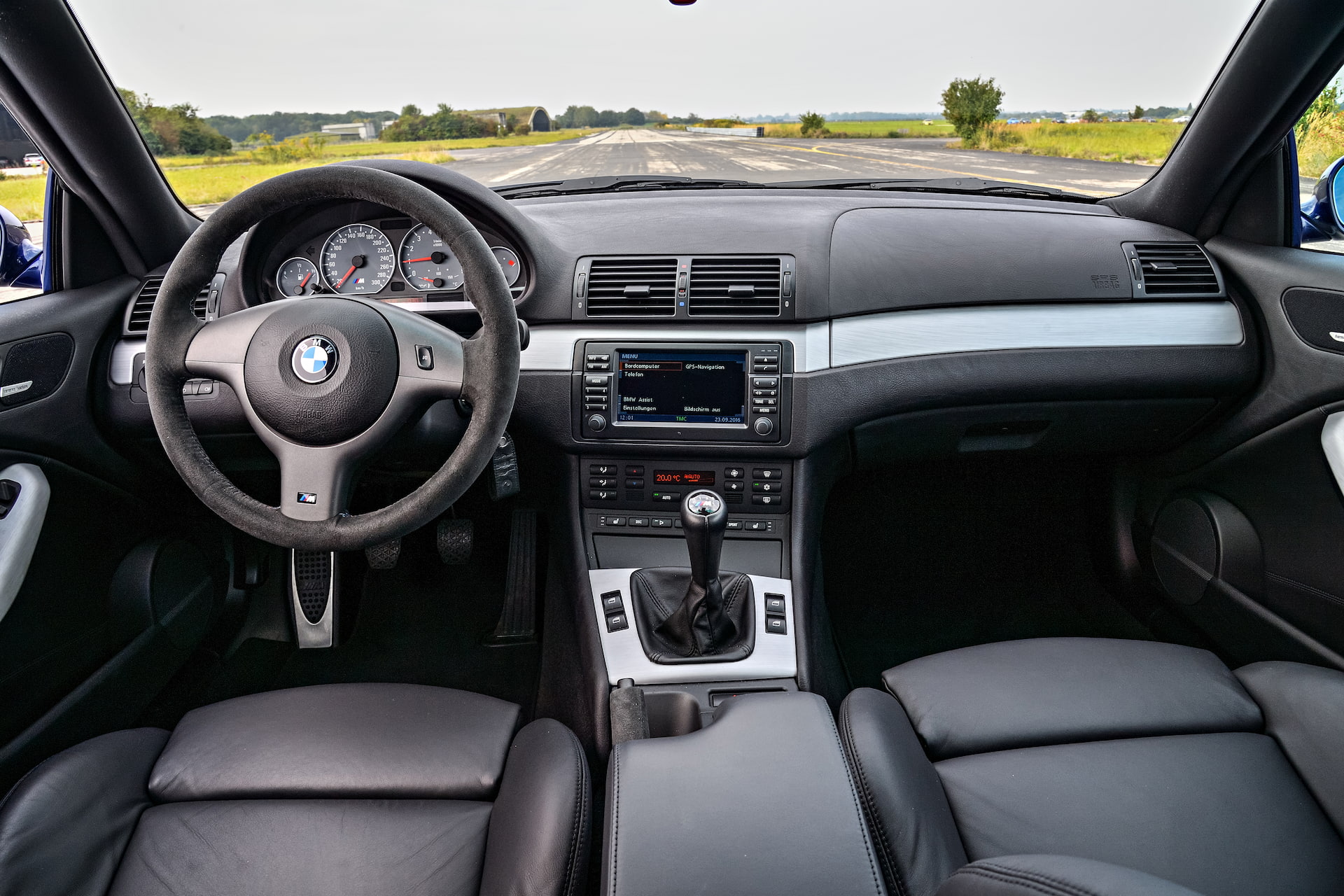
Arguably the most important piece in the interior of a sports car is the seats. Spirited driving is expected; if those seats can’t hold you in, they shouldn’t be there. Thankfully the stock and optional M3 seats do a great job of keeping all occupants in place through those high-speed sweepers we like to call exit ramps. BMW offered them in two flavors; the standard 10-way manually adjustable or the optional 8-way electrically adjustable. From there, buyers could choose their upholstery color with options ranging from mild to wild.
Look at almost every E46 M3 interior, and you’ll find a black dashboard and door panels in nearly every car. Buyers could only choose their upholstery color for the seats and door panel inserts. No matter, though, as BMW offered a handful of great colors that work with the black pieces to create some great-looking two-tone interiors. Extra-cost Nappa leather options included subdued colors like grey and black, warm colors like Imola Red and Cinnamon, and wild colors like Laguna Seca Blue and Kiwi, a pale yellow-green whose color changes depending on the light. For those who didn’t want the extra cowhide, a cloth-centered and an Alcantara-centered seat option existed exclusively for the coupes.
Beyond upholstery material and color, buyers could select the trim they wanted. The trim they chose determined the look of the trim strip across the dashboard, the shifter surround, the door panel armrest trim, and a few other small places. The two most common trims you’ll find are the Titan Shadow and the Brushed Aluminum trim, as they were offered for the longest period. Only the 2001 model year received the High-Gloss Black trim, while the Eucalyptus Malt Wood was special order before becoming an extra-cost option later in production.

A key focal point in the interior is the instrument cluster. It remained a typical BMW product with the familiar font, LCD panels, and overall layout but refreshed the look for a slightly more modern take. The plain black cluster face was broken up by the grey-faced gauges and their aluminum-look trim rings. The readability of the gauges was critical on such a high-strung drivetrain, so BMW devised a unique way of telling the driver when they could drive it hard. Beginning just after 4000rpm on the tach, a series of lights ran to 9000rpm. Those lights would illuminate when the car was on to inform the driver how high the engine could safely rev based on its oil temperature.
Speaking of temperature, the E46 M3’s automatic climate control could be paired with an optional GPS infotainment system. Screens were becoming a regular item for those systems in that era, and the optional GPS was a reasonably fancy option. Now though, they’re outdated at best. Other optional extras could be part of two packages or stand-alone options. Often you’ll find examples equipped with the Luxury package that includes full leather seats, rain-sensing wipers, power seats, and a power moonroof. BMW offered the Cold Weather package for northern drivers, which added heated front seats, headlight washers, and a ski bag. Relatively common stand-alone options were:
- The Harmon Kardon sound system.
- Rear parking sensors called Park Distance Control.
- The Xenon headlights.
What is a BMW E46 M3 Like To Drive?
We have lots of opinions here at FCP Euro, and a majority of them are in favor of the E46 M3. We love the looks, the sounds, and the feelings it creates while driving, though we are aware of the car’s significant shortcomings. However, when in full health, the E46 M3 delivers a superb driving experience in not just our opinion but many others as well. Here are some recognizable names and their thoughts on the old M3.
“The engine is an absolute gem. This ferocious, screaming motor hurtles the M3 down the road with an urgency that now rivals the world's best sports cars from Porsche and Chevrolet.” - Larry Webster - Car & Driver - Dec 1, 2000
“ The 46’s ride is a jaw jangler on busted surfaces, but it has a more neutral, less oversteer-prone feel around Ascari than the E36 and barrels through a slew of corners with friction-free steering and cool composure. Fishtails happen—oh, yes—but they come on more gradually than in the E36 and are easier to ride out.” - Aaron Robinson - Car & Driver - Sep 17, 2010
“We described the E46 as having the ‘most adjustable chassis since the E30 M3,’ in Evo 039 back in January 2002, and if we’re honest, that probably still holds much truth today. The car wasn’t exactly light in its day - in fact, the latest F80 M3 is some 50kg lighter at 1520kg - but its pliant suspension and responsive controls enabled, and still enable, a fantastic sense of connection. Jethro Bovingdon happily explained back in 2004: ‘all M3 owners must quickly become driftmeisters.’ That’s why it comfortably made the cut for our Greatest Drivers’ Cars list in Evo 066, and that’s why is still chosen so frequently by Evo’s road testers as a timeless favourite.” - Sam Sheehan - Evo - Feb 10, 2015
"This inline-six feels more like a healthy V-8, replete with big bags of torque that morph the 18-in. Michelins into uselessly smoking hoops if you're not careful. Shift just as the tach needle breathes halfway into the yellow zone, and you'll avoid the rev limiter that lives a hair's breadth above 8000 rpm. Nail the shifts perfectly (not tough to do with this sweet six-speed box), and you'll rip to 60 mph in 4.65 sec and on through the quarter mile in 13.18 sec/106.92 mph. Pull, sound, finesse-the M3 has it all.” - Motortrend Staff - Motortrend - Aug 1, 2001
BMW E46 M3 Valuation
As a poster child of the 3-series M cars, the E46 M3 has a massive following, with new owners and dedicated original owners waving the flag for twenty-year-old BMW products. Compound that with the electric future making yesteryear's performance cars into collectible items, it's easy to assume that the E46 M3 lives in the upper echelons of the collector car price tier. Thankfully for those looking to buy, that isn't necessarily the case.
Sure, you can find examples of low-mileage, highly optioned coupes that sell for nearly six figures, but that isn't remotely close to the norm. Owners cherished those cars, and they’ll exhibit none of the potential failure points as they've already been handled, or the examples have simply not been driven enough to experience them. That said, you should buy one if you have the spare cash. Values aren't guaranteed to go up, but BMW's M division seems to be trending in the wrong direction as the M cars balloon in size, weight, and complexity. Places like Enthusiast Auto Group should be your go-to for E46-era vehicles, as their knowledge, expertise, and inventory are second to none.
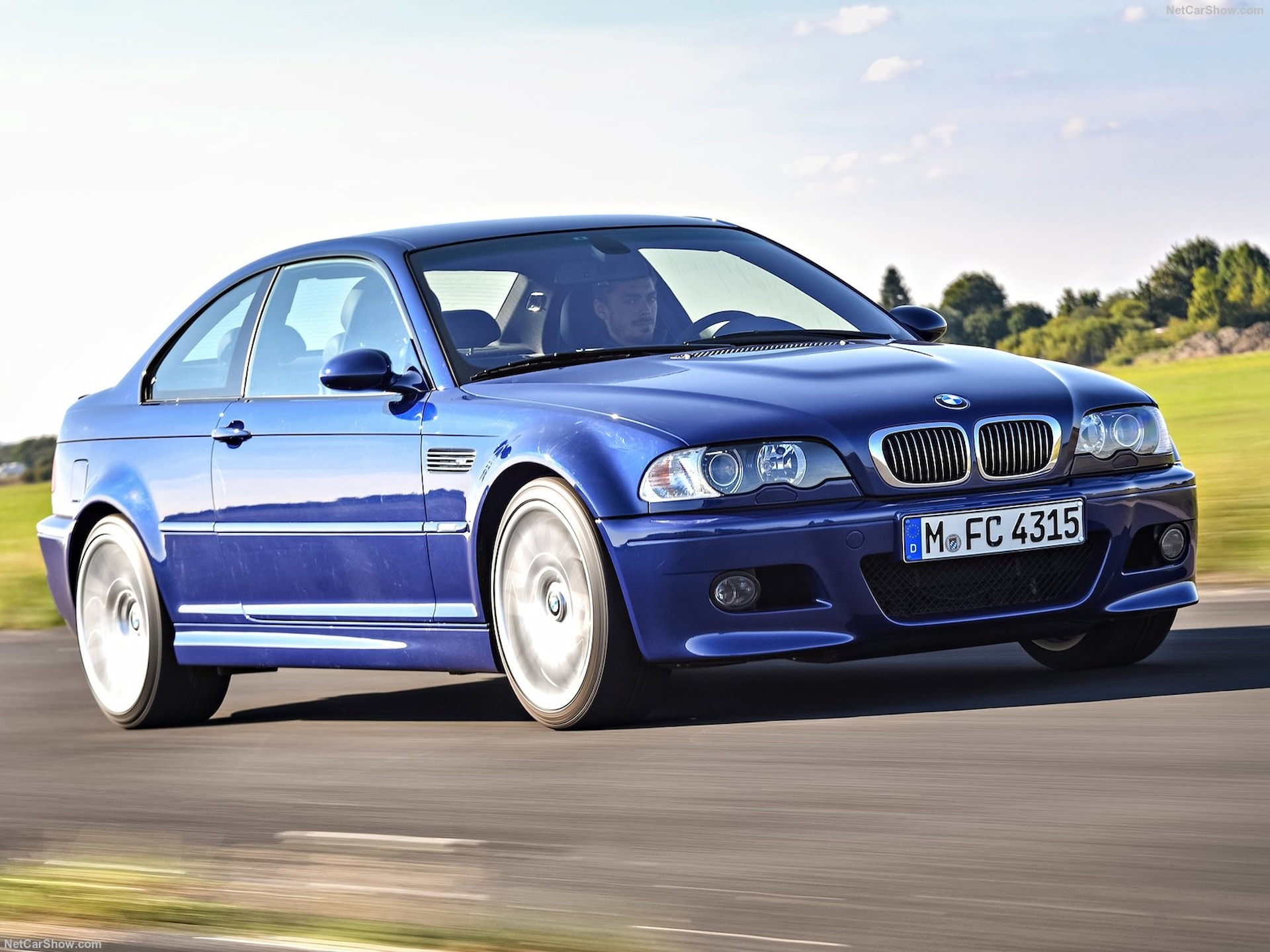
You're better off on an owners' forum or an online auction site like Cars & Bids for something more affordable. Forums are a great place to find cars that have truly been cared for, as active users are usually those most dedicated to the car and its condition. That's not to say you can't find some abused examples there, but I digress. Online auction sites can be another good source of quality broken-in examples, but misrepresentation is much easier in that format. A good seller will have plenty of photos, especially of damaged or worn areas, and be upfront with the car's needs. The kind of examples I'm talking about will have 40,000-90,000 miles on them and be in excellent, better-than-driver-quality condition. Small rock chips will be present but not in any crazy number, and while the seats will show some wear, there won't be any staining or rips in the leather. Drivetrain and chassis issues should've been taken care of as well, so with all that in mind, expect an asking price between $50,000 and $30,000.
True driver quality examples with some paint damage, higher mileage, and possibly suspect history will range from just under the $30k mark to about the $10,000 range. Those bottom-of-the-range examples should have above 130,000 miles and evident wear to interior surfaces and the paint. However, they aren't necessarily bad cars to own as long as the chassis and drivetrain have been looked after correctly. In fact, they'd make an excellent choice for a weekend warrior set to see track time after some improvements and modifications.
Digging a little deeper, you'll find that specific features and options will bring more money than others. The SMG transmissions are typically much more trouble than the standard manuals due to their complex electronics and hydraulics, so expect those models to bring a few thousand less than a coupe in similar condition. The same thing goes for convertibles. There aren't any issues with the top, but the coupes are better for any sort of spirited driving activity thanks to their 200+lb weight advantage. The price gap closes as the condition increases; however, coupes will bring more.
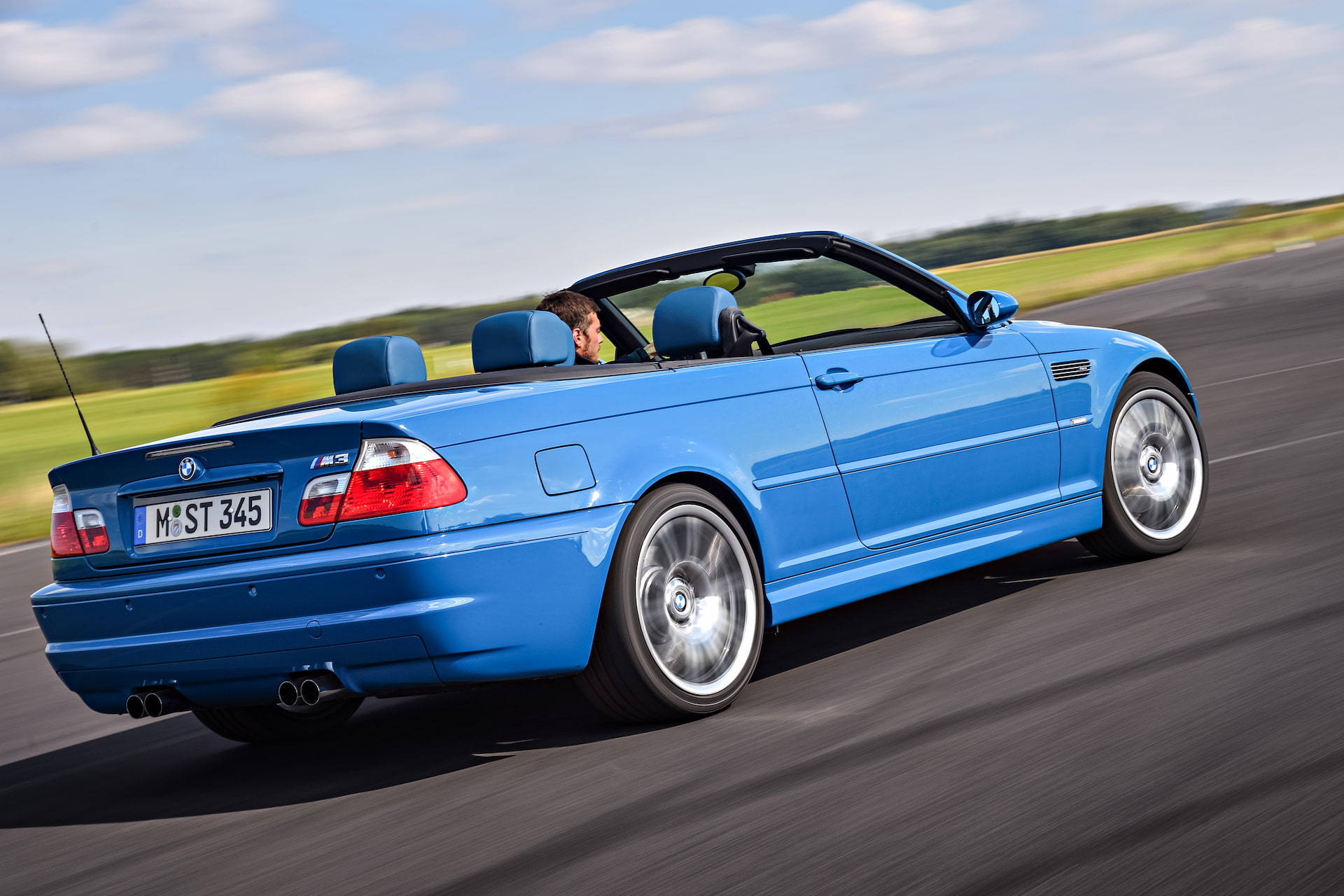
As loved as the E46 M3 is, BMW produced over 40,000 of them for the American market, so it isn't a particularly rare car. Whether or not values climb to stratospheric heights like air-cooled 911s or stay relatively grounded is yet to be seen. The values have increased slowly over the last half-decade, and the recent upswing in the collector car market has affected the E46. Another factor to consider is the final group of pre-teens who were able to experience the E46 when new and in video games are now reaching the age where ownership is possible. Between them, the move away from internal combustion engines, and more recent BMW products failing to deliver a similar driving experience, I'd recommend picking up an E46 M3 at your next available convenience.
Is the E46 M3 Reliable? Cost of Ownership. Are they easy to work on?
You can call an E46 M3 many things, but one in stock form isn’t necessarily reliable. However, with used sports cars, the idea of reliability is different from that of something we’d buy for an everyday vehicle or even a new car. After twenty years of being driven hard and put away wet, any given vehicle’s condition is solely determined by the previous owners and their care for the car. The M3, specifically the S54, was built to very tight tolerances and demanded strict servicing requirements for flawless performance. Of course, we now know that BMW shipped most out with a series of defective parts, so even with proper service came significant issues.
Now though, fixes have been found, and most of the problems have been addressed. Find an example of an M3 that has had its, admittedly quite extensive, list of weak spots resolved, and you will have a reliable but not flawless weekend and warm weather ripper. As with any car, parts wear as you put mileage on them, and knowing when those parts will likely need replacement can play a significant role in anyone’s judgment of reliability. Maintenance and servicing records will always be your friend and make a difference in ownership.
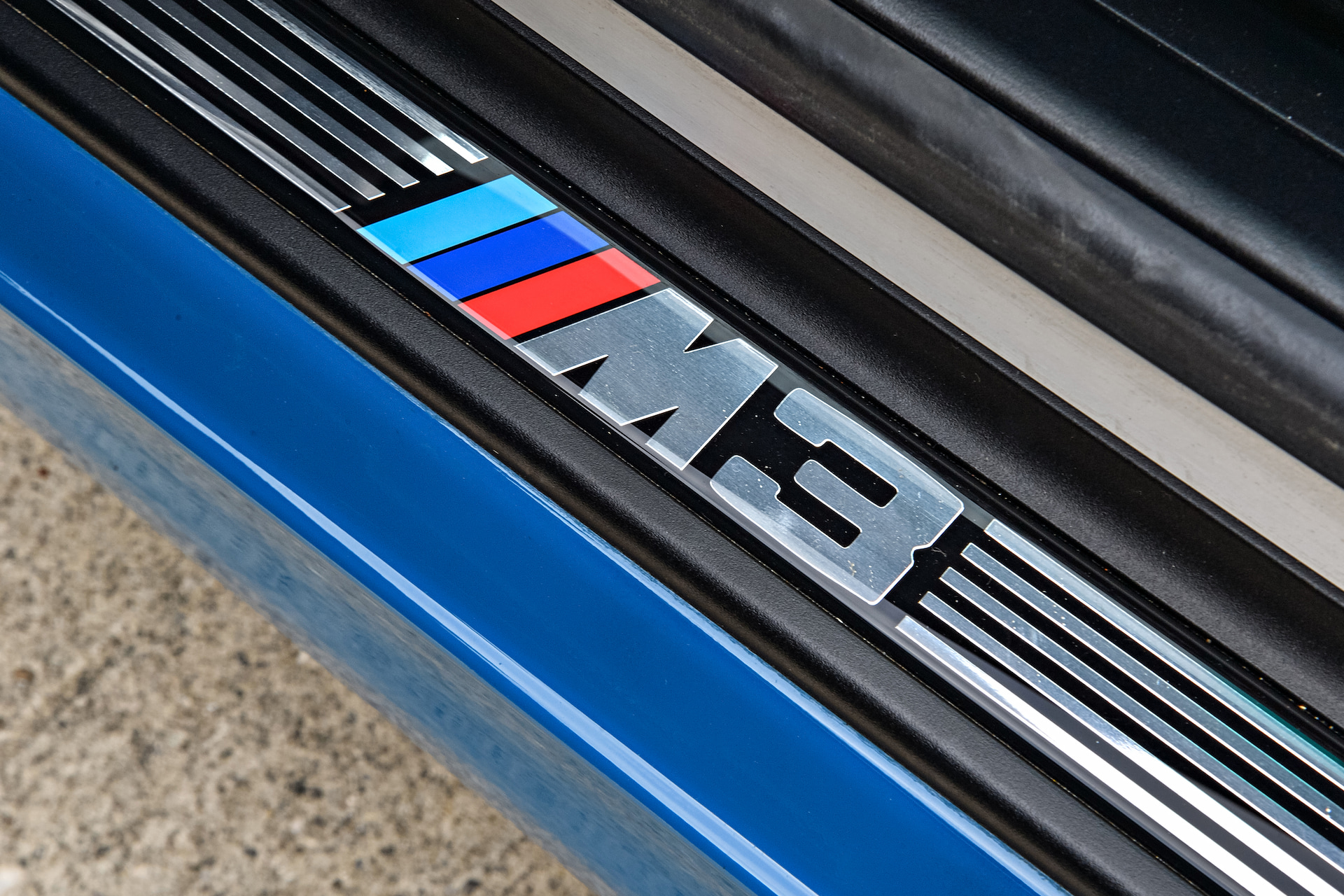
If something goes wrong or it’s time for service, most of the E46 can be serviced and repaired in a DIY setting. It still is just a 3-series, and though the M3 uses several advanced electronic components, they don’t or won’t affect a large majority of repairs. All things chassis-related, like brakes and suspension, can be completely disassembled and repaired with simple hand tools. Engine work will likely be more stressful, but jobs like belt changes, water pump replacements, and exhaust swaps are DIYable without significant issues. More intense jobs like VANOS and rear suspension bushing repair toe the line of DIY capability as they’ll require special tools specific to BMW or larger tools like a press. Still, as long as you can borrow the services of those tools, there are plenty of detailed writeups from trusted sources on how to tackle those jobs.
The ease at which you can repair and modify your M3 is down to your skills. Brake jobs are as simple as they come and are a great place to start for anyone wanting to begin turning wrenches. More involved jobs like coil-over installs and header swaps are certainly more complicated than a brake service, but not in a way that should discourage people from learning or attempting. Move carefully, follow instructions, and check your work; you’ll be fine. If you can, grab a knowledgeable friend or acquaintance. Prior experience and another set of eyes can be a precious advantage. And last but not least, keep your eyes fixed on our DIY blog and our YouTube channel. Both places have a bunch of content focusing on the E46 M3’s strengths and weaknesses and how to repair and service them.











